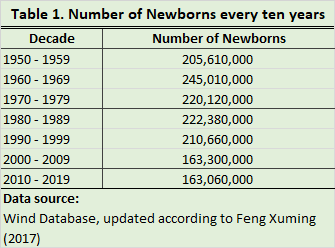Feng Xuming: China's emerging generational demographic cliff: a population decrease of 110 million between the 80s-90s generation and the 00s-10s generation
Feng Xuming
Deputy Director of the Research Office at the National Academy of Economic Strategy, CASS
Research Fellow of ACCEPT, Tsinghua University
Note: The following is an excerpt from Feng Xuming's speech at the Tsinghua University Forum of China and the World Economy on December 27, 2020, accompanied by some additional data. Originally published on the Shuimu Financial Observation official WeChat account, translated by ACCEPT.
Economic development fundamentally comes from the economic activities of hundreds of millions of people, and the ultimate goal of economic development is also to serve these hundreds of millions of people—that is, to meet their growing needs for a better life and promote their all-round development, as proposed in the report of the 19th Party Congress. In other words, people are both the driving force and the purpose of economic development. Thus, changes in population size have always been a crucial variable, if not the most important variable, in macroeconomic analysis.
The total working-age population in China began to fall after a peak around 2012, which has led to obvious changes in the macroeconomy in recent years. What I want to report to you is that the impact of the changing age structure of our population is likely to be even more extensive and worthy of attention in the next ten to twenty years. I call such changes the “generational demographic cliff” in China.
If we add up the number of people born every ten years, we can calculate the population size of what I call the 80s generation, 90s generation, and 00s generation, as shown in Table 1. Among the various generations born after the founding of the People's Republic of China, the 60s generation ranks first in terms of the population size, totaling 245 million, followed by the 80s generation, which comes in at 222 million.
It is worth noting that the number of people born into the 90s generation was 11.72 million less than those born into the 80s generation. In the next decade, the population of the 00s generation was 47.36 million less than the 90s generation, which also means that the population of the 00s generation was nearly 60 million less than that of the 80s generation. However, the population of the 10s generation is roughly equal to that of the 00s generation.
Two scenarios can be analyzed as follows to help us better understand the impact of these population changes:
First, if we combine the generations to form the 80s-90s generation and the 00s-10s generation, we can see a population decrease of 110 million between these two broader generational groups. In 2020, the youngest members of the 00s generation will turn 20 years old. Many of them have already entered the workforce, while those who are in college will begin working in a few years. Over the next 10 to 20 years, it is foreseeable that the total number of young people engaged in economic activities will decrease significantly compared to the previous two decades.
Second, if we combine the 60s, 70s, and 80s generations into the 60s-80s generation, we get a demographic group whose members are all 31-60 years old in 2020—the backbone of every trade and profession. If we combine the 90s, 00s, and 10s generations into the 90s-10s generation, members of this demographic group will all be 16-45 years old by 2035 and 21-50 years old by 2040—at this point, they will enter their golden age and become the new driving force in every sector. From the statistical data, we can see that the total population of the 90s-10s generation is 150 million less than that of the 60s-80s generation.

Both 110 million and 150 million are significant numbers in terms of population. There are only 15 or so countries in the world with a population of more than 100 million, and even many large developed countries have a population smaller than that. For example, according to the World Bank, the populations of Germany, the United Kingdom, and France were 83.13 million, 66.83 million, and 67.06 million, respectively, in 2019. This gives us some idea of the magnitude of the generational demographic cliff that China is facing—not so far in the future, the population gap between generations separated by only 20 years will exceed 100 million.
Such drastic changes in population size among generations will have broad implications. This is confirmed by a study I did last year on the changing consumption patterns of young people. For example, housing demand in some regions and cities is likely to contract significantly in the future, especially at the micro level, as the “4-2-1” family structure (consisting of four grandparents, two parents, and one child) leads to a structural imbalance between housing supply and demand. Moreover, the pressure to balance the accounts of social security funds, such as pension and health insurance, may continue to increase, while the pressure to maintain sustainability in infrastructure investment and financing will also rise. In addition, the automotive, energy, electronics, education, healthcare, elder care, and insurance industries will also inevitably be affected by these changes.
Here, I must make two final points. First, due to different mortality rates and average life expectancies across generations, there may be differences between the above estimates based on the number of births and the true population. However, these differences should be small, and we can renew our calculations after the results of the seventh population census are released. Second, the generational demographic cliff in China will, to some extent, be a gradual process rather than an abrupt change in a certain year. However, the impact of a continuous population decline within one to two decades will still be significant. The business sector and relevant government departments should properly account for this and ensure they are fully prepared.




